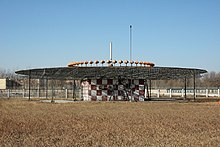User:Chetvorno/work
For isotropic radiator
[edit]An isotropic radiator is a theoretical point source of radiation (waves) which radiates the same intensity of radiation in all directions.[1][2][3][4] That is, the power density of radiation at every point at a given distance from the source, on a sphere centered on the source point, is constant.
The radiation field of an isotropic radiator in empty space can be found from conservation of energy. The waves travel in straight lines away from the source point, in the radial direction . Since it has no preferred direction of radiation, the power density [5] of the waves at any point does not depend on the angular direction , but only on the distance from the source. Assuming it is located in empty space where there is nothing to absorb the waves, the power striking a spherical surface with the radiator at center, regardless of the radius , must be the total power in watts emitted by the source. Since the power density in watts per square meter striking each point of the sphere is the same, it must equal the radiated power divided by the surface area of the sphere[3][6]
Thus the power density radiated by an isotropic radiator decreases with the inverse square of the distance from the source.
Since the power density of electromagnetic or acoustic waves is proportional to the square of intensity of the fields that carry the power (the electric and magnetic fields of an electromagnetic wave, the sound pressure field in a sound wave) , the fields decrease with the inverse of distance from the source. For example for an electromagnetic wave so for an isotropic radiator where is the peak value of the sinusoidal electric field of the wave in volts per meter, and is the impedance of free space, 377 ohms.
The term isotropic radiation is used in two senses in physics. When discussing an isotropic radiator it may mean the radiation field described above; the waves directed radially away from the source point, with power density decreasing as the inverse square of the distance. However in thermodynamics it usually refers to a different radiation distribution: that which would be found at thermodynamic equilibrium, as in a black thermal cavity at a constant temperature.[7] In a cavity at equilibrium the power density of radiation is the same in every direction and every point in the cavity, meaning that the amount of power passing through a unit surface is constant at any location, and with the surface oriented in any direction.[8][7] This isotropic radiation field is different from that of an isotropic radiator.
- ^ Graf, Rudolph F. (1999). Modern Dictionary of Electronics. Newnes. p. 398. ISBN 9780750698665.
- ^ "Isotropic radiator". Electronic engineering glossary. In Compliance magazine website. 2009. Retrieved 28 February 2024.
- ^ a b Richards, John A. (2008). Radio Wave Propagation: An introduction for the nonspecialist. Springer-Verlag. pp. 1–2. ISBN 9783540771241.
- ^ Weik, Martin H. (1989). Communications Standard Dictionary, 2nd Ed. Van Nostrand Reinhold. p. 555. ISBN 9781461566748.
- ^ The angle brackets indicate the average over a cycle, since the power radiated by a sinusoidal acoustic or electromagnetic source varies sinusoidally with time
- ^ Carr, Joseph J. (1996). Microwave and Communications Technology. Newnes. p. 171. ISBN 0750697075.
- ^ a b Howell, John R.; Menguc, M. Pinar; Siegal, Robert (2016). Thermal Radiation Heat Transfer, 6th Ed. CRC Press. p. 15. ISBN 9781498757744.
- ^ Demtroder, Wolfgang (2010). Atoms, Molecules, and Photons. Springer. p. 83. ISBN 9783642102974.

- Instrument Landing System (ILS) - A short range radio navigation aid at airports which guides aircraft landing during instrument flight conditions (IFC), at night or in bad weather. It consists of multiple antennas at the end of each runway that radiate two beams of VHF radio waves along the approach to the runway: the localizer (108 to 112 MHz frequency), which provides horizontal guidance, a heading line to keep the aircraft centered on the runway, and the glideslope (329.15 to 335 MHz) for vertical guidance, to keep the aircraft descending at the proper rate for a smooth touchdown at the correct point on the runway. Each aircraft has a receiver instrument and antenna which receives the beams, with an indicator to tell the pilot whether he is on the correct horizontal and vertical approach. The ILS beams are receivable for at least 15 miles, and have a radiated power of 25 watts. ILS systems at airports are being replaced by systems that use satellite navigation.












